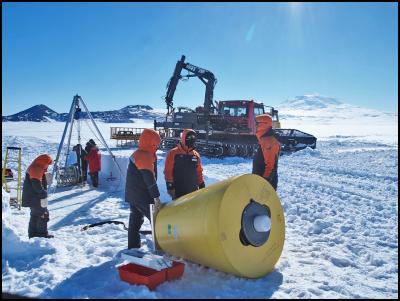Scientists probe beneath Antarctic ice shelves

Ice Tethered Profiler being deployed in Antarctica by NIWA and Antarctica NZ staff. Mount Erebus in the background.
NIWA Media
Release 22 November
2010
Scientists probe beneath Antarctic ice
shelves
NIWA looks below Antarctic ice shelves to investigate the polar ocean system with a new high-tech probe.
NIWA’s new Ice Tethered Profiler (ITP) places NIWA at the forefront of polar oceanography. It gives NIWA, and international scientists, insight into the interaction between the ocean, Antarctica’s sea ice, and ice shelves – thereby unlocking mysteries in Antarctic polar oceanography.
NIWA transported the ITP to Antarctica. It was deployed by NIWA scientist Craig Stewart, and IRL’s Tim Haskell. The very first set of data from below the ice was sent via satellite on 19 November 2010.
It will provide NIWA with the first-ever year-round data set of what is happening beneath the ice in McMurdo Sound. The ITP collects temperature and salinity profiles. This information is relayed in real-time, via satellite, to the Woods Hole Oceanographic Institute website.
“This will lead to a better understanding of the interactions between the ice sheet, the oceans, and what contribution this is making to sea-level rise. We are trying to understand how the ice shelf interaction is changing over time,” says NIWA oceanographer, Dr Mike Williams.

The Ice Tethered Profiler underwater vehicle profiles up and down the wire rope tether on a pre-programmed schedule sampling the water's temperature, and salinity properties.
After each one-way profile, the data set is transferred between the underwater vehicle, and the surface module through the wire- rope tether using an inductive modem, and from the surface module to shore via satellite.
Woods Hole Oceanographic Institute group manufacture the Ice-Tethered Profiler in conjunction with McLane Research Laboratories.
In the Northern Hemisphere, the Arctic has lost vast amounts of its sea ice. In the Southern Hemisphere, such changes have so far largely appeared along the Antarctic Peninsula.
Predictions for the next century could see Antarctic annual mean sea ice decrease by 24%, so it is important that interactions between sea ice and both atmosphere and ocean are understood.
“The Ross Sea is fresher than it was 30 years ago, because the Antarctic ice sheet has been melting, and putting more freshwater into the ocean,” says Dr Williams.
“The warmer the water, the faster the ice melts, so what we are starting to see is warmer parcels of water making their way to the coast, and starting to increase the ice-shelf melt in coastal Antarctica.”
Polar regions are where climate change is
happening most rapidly. “It’s well understood in the
Arctic, but in Antarctica we don’t really understand why
we are not getting the same response. Our measurement
programmes are decades behind what’s happening in the
Arctic, and the ITP gives us a chance to start catching
up,” says Dr Williams.
The ITP was developed by Woods
Hole Oceanographic Institute, funded by NIWA, and its
deployment is supported by Foundation for Research, Science
and Technology, and Antarctica NZ. It is the second ITP to
be deployed in Antarctica.
NIWA CEO John Morgan will be
on the ice 24-26 November as part of the Antarctica New
Zealand Invited Visitor
programme.
Background:
How does
the ITP work?
The ITP consists of a surface
capsule that sits on top of a large area of ice floating on
the surface of the sea. It supports a plastic-jacketed wire
rope tether that extends through the ice, and down into the
ocean. It is weighted at the bottom. A cylindrical
underwater instrument mounts on this tether and cycles
vertically along it, carrying oceanographic sensors through
the water column.
Other information about this item
To find out how the ITP works,
see the animation at:
www.whoi.edu/page.do?pid=20756&tid=1061&cid=32063&cl=24072&article=37946
Visit www.whoi.edu/itp for more information.
Visit www.whoi.edu/itp/itp40data to see the data.
ENDS


 Netsafe: Netsafe And Chorus Power Up Online Safety For Older Adults
Netsafe: Netsafe And Chorus Power Up Online Safety For Older Adults RBNZ: 10 Cent Coin With King Charles III Image Now In Production
RBNZ: 10 Cent Coin With King Charles III Image Now In Production NZALPA: Safety Improves From AKL Incident Learnings
NZALPA: Safety Improves From AKL Incident Learnings NIWA: Antarctic Footprint Clean-up Challenges - How A Remote Antarctic Base Clean-up Protected One Of Earth’s Clearest Lakes
NIWA: Antarctic Footprint Clean-up Challenges - How A Remote Antarctic Base Clean-up Protected One Of Earth’s Clearest Lakes Hugh Grant: Can A Meme Coin Become A Real Payment Solution?
Hugh Grant: Can A Meme Coin Become A Real Payment Solution? Imported Motor Vehicle Industry Association: EV Battery Fires Expose New Zealand Regulatory Gap
Imported Motor Vehicle Industry Association: EV Battery Fires Expose New Zealand Regulatory Gap 


